Teacher. Wildlife Biologist. Zookeeper.
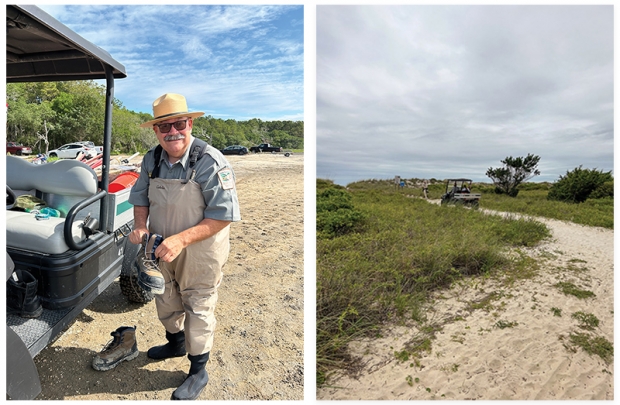
Very few Grand Strand residents and visitors are unaware of the two marvelous state parks that grace our shores: Myrtle Beach State Park, the oldest state park in South Carolina (1936), and further south in Murrells Inlet, Huntington Beach State Park, named for the Huntingtons of Brookgreen Gardens fame, who donated the land through leases to the state in 1960, with the park opening in 1962.
At the 2,500-acre Huntington Beach State Park and coastal preserve, birders, nature and wildlife lovers, the camping crowd, fishermen, beachgoers, and picnickers descend en masse from spring through fall, though the Park always has visitors year-round, 24/7. The parks estimate hosting more than one million visitors per year.
Off and on since 1991 (mostly on), and permanently since 2001, Park Ranger Mike Walker has been a familiar face to tens of thousands of visitors, and especially school groups, who he leads through various programs that change with the seasons. Though his office and desk are located at the Park’s Nature Center, it’s far more likely you’ll catch Walker out and about on his ATV in nearly every nook and cranny of the Park, including at Oyster Landing, just a mile or so north of the park entrance, where kayakers, fishermen and shellfish harvesters are often found.
We wondered what a typical day for Ranger Walker might be and found that there’s really no such thing. I recently spent a good part of a day with the ranger and 50 of his closest friends, school children from Ocean Bay Middle School, on their last field trip before summer break.
10:15 a.m.
Freshly out of a Thursday morning staff meeting, Ranger Walker and his intern, Kelsey Baran, who will start in the marine biology program at Coastal Carolina University this fall, arrived at Oyster Landing in style, ATV loaded down with the tools of their trade: rakes, shovels, waders, boots, buckets, and a seine net. They met the Ocean Bay kids, their teachers and chaperones and even a documentary film crew visiting the Grand Strand from Cornell University. For Walker, it is just another day doing what he loves best.
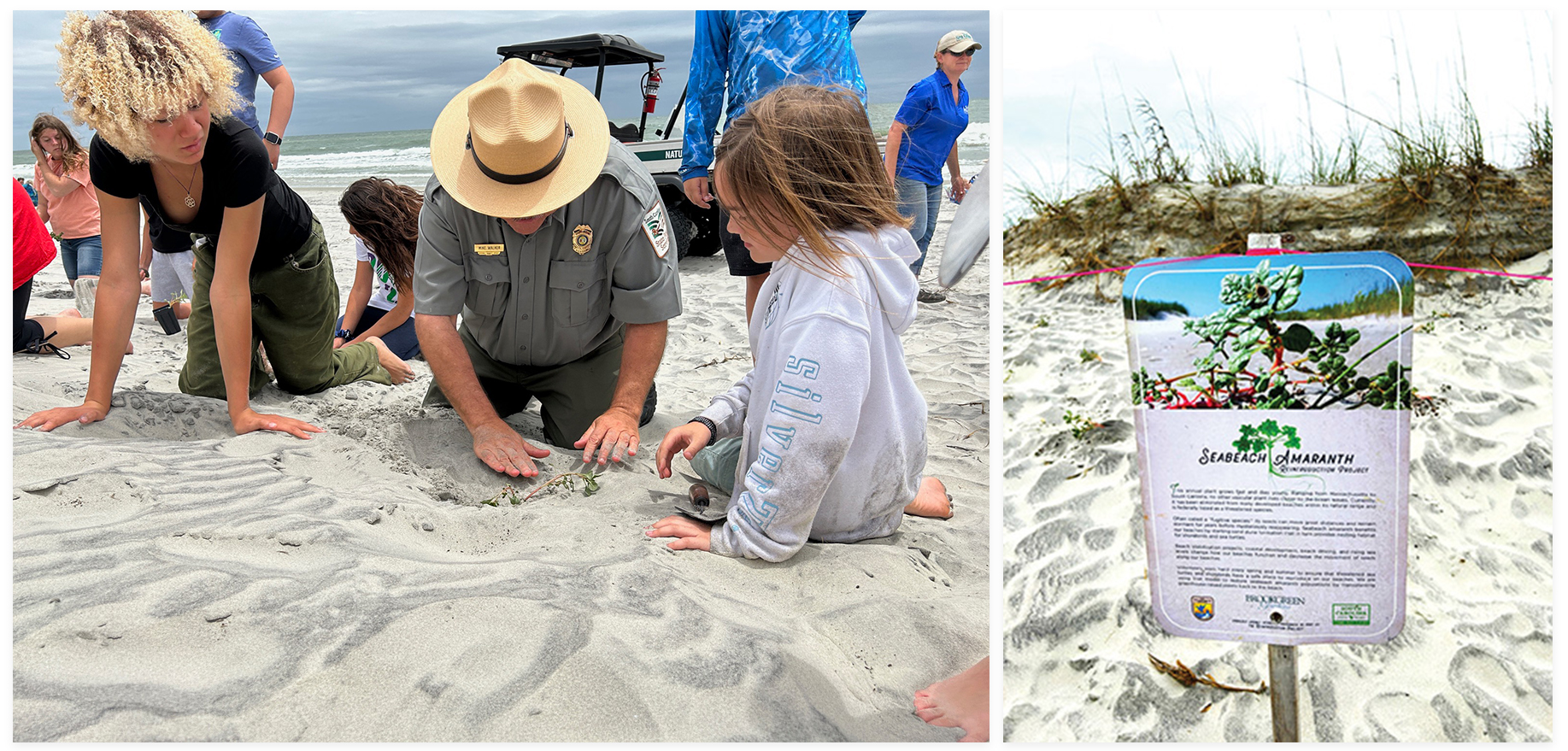
“I’ve been able to turn my hobbies into paid work,” he says. “I absolutely love it.”
A graduate of the University of South Carolina’s marine biology program, Walker, 58, is well trained for the tasks at hand. He’s friendly and sports a ready smile barely hidden by a thick mustache. His traditional Campaign Hat shields him from the sun as he dons special waders and boots that will keep him mostly dry as he prepares to enter the thigh-deep water with a seine net, part of the morning’s hands-on program.
Born and raised on St. Helena Island in Beaufort County, S.C., Walker fell in love with the Lowcountry flora and fauna at an early age, with an emphasis on its sea life.
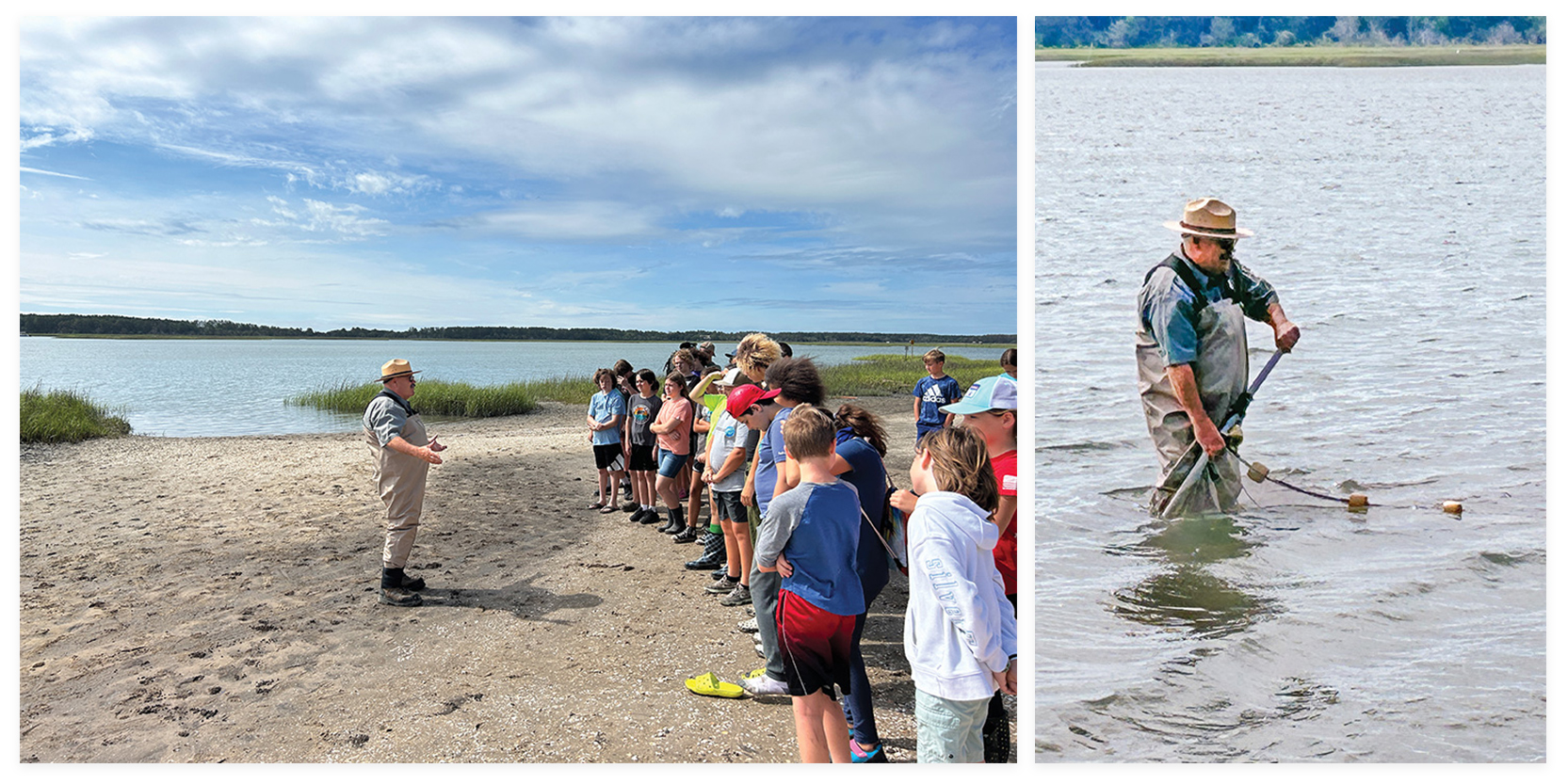
“I grew up in the heart of Gullah country,” he notes. “It’s a beautiful part of the state. As a kid, I would go to Hunting Island all the time. When I was 5, I found a megalodon shark’s tooth as big as my hand. It triggered something in me and started a lifelong love of marine science.”
The lively but well-behaved 11- and 12-year-olds, part of the school’s Science Club, are eager to get started on the fun. Each kid will have the opportunity to get wet as they drag a seine net through the shallow water to see what might turn up. Walker and Baran demonstrate.
“Let’s see what we have,” he says to the attentive kids gathered around as they make their way back out of the water.
“These are mullets,” he says pointing to tiny little silver fish about an inch long. “They can grow quite large and are often used as bait. Here’s a small blue crab, a white shrimp, and a hermit crab.”
The animals are placed in a Ziploc bag with a little fresh ocean water and passed around to the group before being released back into the salt marsh.
“I am the Interpretive Park Ranger,” Walker tells me as the kids ooh and ahh over the fresh catch. “I’m in charge of the Nature Center and manage a wide variety of activities and park functions. There’s a lot of administrative work, but I’m outside a good part of every day or in the Nature Center taking care of the animals and meeting with the volunteers. I tell people I’m one-third teacher, one-third wildlife biologist, and one-third zookeeper.”
The Ocean Bay teachers proudly point out the fruits of their labors over the past several years. Previous groups of kids participated in the spartina grass-planting program that has turned a large muddy bank at Oyster Landing into a thriving regrowth of the native grass, home to many species.
Walker, teachers, and volunteers, lead the kids in these activities for the next hour or so before loading up the bus and heading back to the park.

Noon
Meeting at Shelter 1, nestled up to the west side of the massive dunes beachside at the park, Walker takes a lunch break with the film crew and teachers just before the group’s next task: planting rare seabeach amaranth, once thriving along the South Carolina coast and now almost completely gone. The grass helps hold the dunes together to protect them from erosion.
1 p.m. “No two days are alike,” confirms Walker, who is waiting for delivery of dozens of individually potted amaranth grown in the nurseries across the street at Brookgreen Gardens. “These plants were grown from seeds I harvested from some of the last naturally occurring amaranth on the coast.”
He shows the kids how to dig a hole in the sand, carefully remove the juvenile plants from their pots, and plant them, a task the students take to enthusiastically. The kids may be tomorrow’s marine scientists and maybe getting the hands-on experiences will help them decide on a career path. After watering and protecting the fledgling plants with stakes and yellow tape, they look on proudly at the day’s achievements.
Walker leads a teacher to the first aid kit stowed on his ATV to help with a splinter removal for one of the kids.
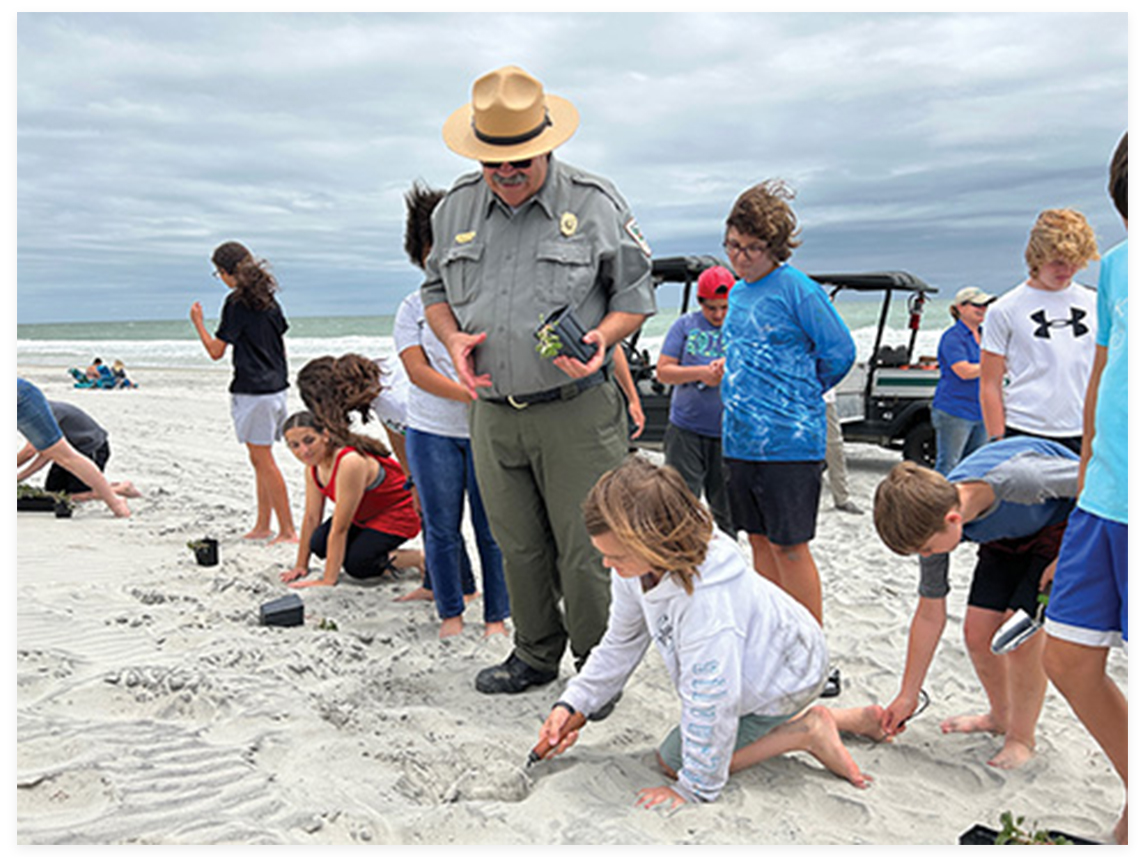
2 p.m.
With the kids packed up, the buses rolling out of the parking lot, and the film crew having said their goodbyes, Walker makes his way back to the Nature Center. Before we go upstairs in the recently rebuilt facility (the original Nature Center was destroyed by fire in 2016 after a lightning strike), we stop by the bird feeders.
“There’s a painted bunting,” he says, pointing to an impossibly multi-colored bird at a feeder near the edge of the salt marsh of Mullet Pond. Huntington Beach is well known among birders from around the nation and around the world. Nesting bald eagles, ducks, razorbills, and black guillemots are among the most coveted sightings, as they take to the man-made rock jetty at the north end of the park. The beach is home to shorebirds, including the federally endangered piping plover.
Upstairs, a group of kids test their bravery touching living but benign sea life in a large saltwater tank. Walker takes the time to explain the more interesting points of the horseshoe crab and small ray’s biology as the animals float and swim in lazy circles.
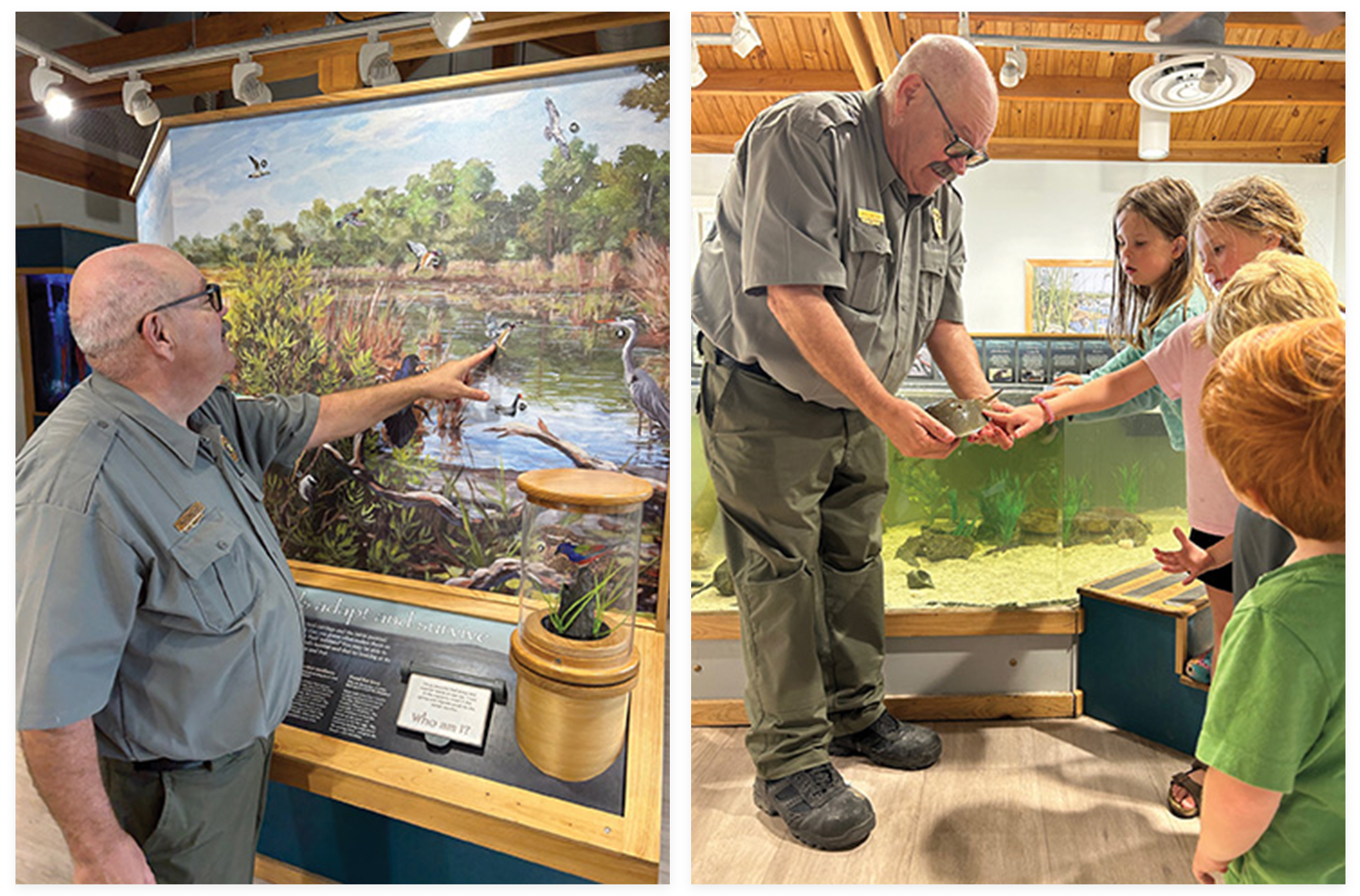
Baby alligators, turtles and interactive educational displays are found throughout the Nature Center. A half-dozen pair of binoculars are waiting at the ready for anyone wishing to view wildlife from the large windows facing the salt marsh.
With the programs for the day concluded, Walker will set to work on updating the website with plans for the late summer and fall programs. Running through the end of August there’s still plenty of opportunity for visitors of any age to participate: catch-and-release crabbing, tours of the Huntingtons' winter home and art studio, Atalaya, coastal birding, alligator observations, and Nature Center lectures, outdoor animal encounters, and even ghost tours.
“I’ll have Zoom meetings, coordinate with volunteers, and handle supply procurement,” says Walker, “and I do a lot to coordinate with school groups who want to come, and who knows what else?”
“I still have that megalodon tooth,” remarks Ranger Walker, referring to the one he found some 53 years ago. “It’s broken and been glued back together a hundred times, so it’s not going to win any beauty contests, but I still have it.”